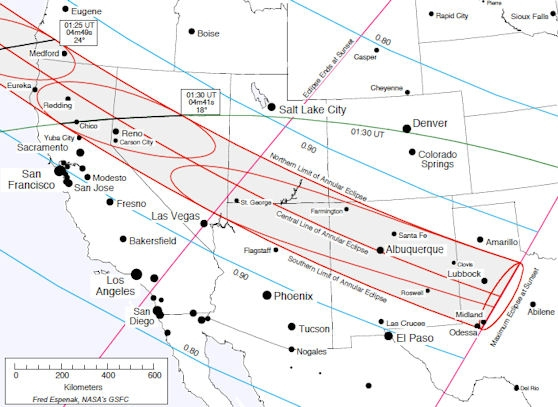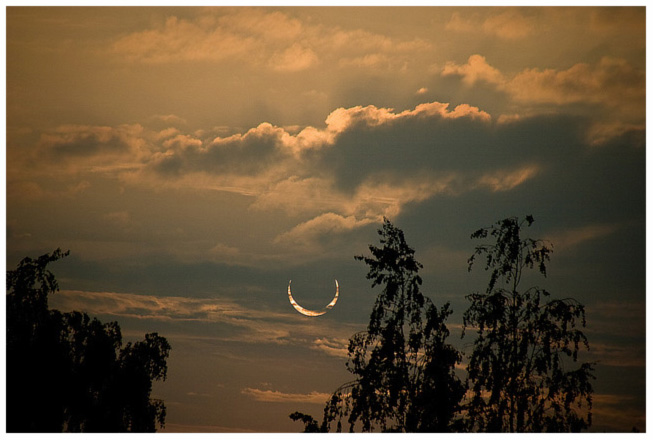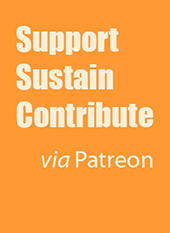 Map courtesy of NASA. You can download a much clearer PDF of this same map from the NASA website linked in this article.
Map courtesy of NASA. You can download a much clearer PDF of this same map from the NASA website linked in this article.
By Ctein
I don't know how this one slipped past me, but it did. Maybe I've been too fixated on the total solar eclipse coming up in 2017. Be that as it may, there's a real nice annular solar eclipse in less than five months.
When the Moon passes directly in front of the sun, but the moon's too far away to entirely cover the sun, you don't get a total eclipse; instead you're left with a ring of fire rimming the black moon. That's an annular eclipse.
Annular eclipses are pretty neat, considerably more so than partial eclipses, but they're not in the same league as total eclipses. If a partial eclipse is a 1, then an annular eclipse is maybe a 4...but a total eclipse is a 999,999. In other words, they're worth going to bit out of your way to see, but don't plan a major expedition unless you're a complete eclipse junkie.
Fortunately for a high percentage of the Western U.S. population, this one will not require such an expedition. The eclipse happens a bit before sunset (approximately 6:30 p.m., Pacific daylight time). The centerline of "totality" (well, annularity, if you're gonna be picky about it) makes landfall on the Pacific coast about 50 miles north of Eureka, California. The total footprint for "totality" is nearly 200 miles wide, including both Eureka and Medford, Oregon.
The track heads southeast, passing just north of Reno and directly over Albuquerque. It finally peters out around Lubbock, Texas at sunset. As annular eclipses go, this is a pretty long one, lasting about 4 1/2 min. At the Pacific Coast, it will occur when the sun is about 22° above the western horizon. At Lubbock, the sun will be kissing the ground when the eclipse peaks.
This is good news. Annular eclipses are not, in and of themselves, especially striking photographic subjects. What makes them interesting is when you can photograph them against some kind of background. The photograph on the NASA website describing this eclipse is a nice example of that.
While not worth a major expedition, annulars are worth a day's drive. The timing of this eclipse is ideal. It's very late afternoon on a Sunday. If you're willing to play hooky from work on Monday, you can drive to a viewing spot on Sunday, grab a motel room for the night, and drive back on Monday. That's what Paula and I are going to do. Assuming you're willing to get a decently early start on Sunday, you can go see the eclipse if you're anywhere within a band bounded by Seattle, Salt Lake City, and Denver on the north, San Diego and Tucson on the south, and Dallas on the east.
Where you go will depend on where you're located and how much you feel like gambling. Ignoring unpredictable weather occurrences, your best chance for seeing the eclipse is when it's higher in the sky, as cloud cover usually increases towards the horizon. On the other hand, the closer it is to the horizon, the better the opportunities for dramatic compositions. You pays your money, you takes your chances.
Note well!
Now, this part is really
important: an annular eclipse is like a partial solar eclipse; the
portions of the sun that are not blocked by the moon are just as bright
as always. Unless you are in a location where you're viewing the
eclipse right at sunset, you cannot safely view this with the naked
eye. You need a good blocking filter, or you risk blindness.
Crossed polarizers or fully-developed color/chromogenic films are not good blocking filters! They let through most of the infrared, which you can't see. You'll think it's safe to look, but your retina will learn otherwise. It is much, much more dangerous to look at the sun through something like this than to look at it with the naked eye. It's hard to stare at the sun very long with the naked eye; these faux-filters make it very easy. Check online regarding your options for proper solar viewing filters. Any good astronomy website will have many recommendations.
Note, by the way, that your camera's film, sensor, and shutter curtains will also not be terribly happy having undiminished infrared light focused upon them. It's not just your eyes you have to worry about.
For just viewing, fully-fogged B&W silver film is safe, but it's too blurry for photography. For photography, Wratten 96 neutral density filters are a good choice; they have broadband absorption and are optically very "clean." An ND 3.0 filter is a good choice in a situation like this. Caution: don't use the Wratten filter for visual viewing—while it absorbs a considerable amount of the infrared, after some considerable digging into the literature I cannot determine to my satisfaction that it absorbs enough to make it eye-safe.
The object of your attention in an annular eclipse is no bigger than the sun; there is no extended corona to be seen. That means you'll be wanting a long telephoto lens. Each 100 millimeters of focal length gets you 1 millimeter of sun image size in the film/sensor plane. Unless you're working with an extremely small format camera try to get at least a 500mm lens, 1000mm if you're working in 35mm (film or sensor) format.
Mark your calendar, if you're anywhere close to the eclipse track. You won't be getting another chance soon.
Ctein
Featured Comment by Mathias Vejerslev: "Here's a shot I got of a partial annular solar eclipse back in 2003. I'd have to say it was worth staying up all night even for a partial, annular solar eclipse.
"By the way, this image reached front page on BBC World and was sold to a few astronomy magazines within just a few hours of capture (and before I even had a chance to catch up on my sleep)."
Ctein replies: Wow, Mathias, that's one of the nicest annular eclipse photos I've ever seen. Since your conditions were similar to what a lot of viewers will have with this eclipse, mind sharing your technical data (lens, ISO, exposure, filter if any) with us, as best as you can recall?
Mathias replies: "Thank you very much Ctein. I'd love to share details. So, best I can recall I was shooting with a Canon 10D and a mediocre and slow Sigma 28–200mm zoom that wasn't even chipped for digital cameras, meaning it could only shoot wide open! At the time, it was all I had available to me in order to magnify the sun just a bit. On a tripod of course (like that would cure the smear of the bad lens).
"Now, shooting into the sun with a zoom lens isn't really very smart. Just framing real quick through the viewfinder burned semi-permanent black spots into my good eye. Don't do that, folks! Use live view or something else, never look at the sun directly!! I checked and it really is dangerous. Anyway, I documented the whole sunrise and it was quite an experience. The climax, seen here, was at sunrise, at 5:33 a.m. on May 31, 2003. The rest of the EXIF can be seen on this flickr page (click Actions > View EXIF Info).
"Like most of my 'event astronomy shots' this was shot in good comfort from my own balcony—the only trick here is knowing when to look up. Also, for those that have never witnessed a solar eclipse before, be mindful of the shadows (even in my image—see the clouds), which will take on a circle of confusion shaped like the eclipse! and of nature reacting—the chilling, the dimming of the light, and the animals acting strange. It is...quite special. Enjoy.
"P.S.: Funny how the two images I've got featured here on TOP are both eclipse shots—only the other one is lunar. Thanks again."


I think I noted this when I was looking at 2017, but I skipped it as not conveniently located and not total. Which is too bad, because a practice run for 2017 isn't a bad idea at all.
Posted by: David Dyer-Bennet | Wednesday, 22 February 2012 at 11:23 AM
Also, a transit of Venus across the disk of the sun will occur on June 5. The next will not occur until 2117.
Posted by: mph | Wednesday, 22 February 2012 at 11:25 AM
If you can keep a secret, if you travel to Albuquerque, taking the Tram to the Crest should provide an excellent view, assuming there are no clouds. Of course, if a million other photographers figure this out...
Posted by: KeithB | Wednesday, 22 February 2012 at 12:35 PM
Hooray! Eureka is my home, but I know my coastal redwoods country well and know several nice places 20 to 50 miles north of here. The only possible bummer will be fog, which could - as it has in the past - just wipe it out. Prayer doesn't seem to help much!
Posted by: Dave Van de Mark | Wednesday, 22 February 2012 at 12:51 PM
In 1999 I witnessed a 99% at a US/Dutch airbase in Holland, what I remember most is not the eclipse itself but (as a biologist) the response of nature around me.....it was august and every bird fell silent, the temperature instantly dropped several degrees and even we (the Dutch ICT technitians and even our American colleges) lowered our voices...sort of a natural respons I guess.
Greetings, and have fun all you west-coasters and alike,
Ed
Posted by: Ed | Wednesday, 22 February 2012 at 01:27 PM
Slightly off-topic, but HOLY COW! I just checked NASA's map for the 2017 total eclipse, and not only will the central line of the eclipse path pass within six miles of my house, I'm also less than a hundred and fifty miles from the point of greatest eclipse.
Anybody have any recommended reading (other than Ctein above, of course) for those interested in maximizing such a great opportunity? I've only got five and a half years to figure it all out...
Posted by: Ben Marsee | Wednesday, 22 February 2012 at 01:56 PM
Bah, this would happen while I'm planning to be halfway across the world.
Posted by: Ben Rosengart | Wednesday, 22 February 2012 at 01:58 PM
Dear DDB,
Yes, it would be over a 1000 mile drive each way for you. A bit much.
But, if it would be any consolation, it would make a lousy practice run for the 2017 total eclipse. The photographic conditions and constraints are so very much different that it makes experience with one irrelevant for the other. Light is not in short supply during an annular eclipse, it is during a total one. A total eclipse involves some very subtle tone and color variations. An annular eclipse does not. A total eclipse can involve trying to photograph a very long subject luminance range. An annular eclipse does not (the brightness difference between the sun and anything else be so large that, except that sunset, you're basically photographing son and silhouettes; there is no shadow detail to even try to capture).
In summary, I don't think there are any lessons you could learn from the 2012 eclipse that would apply to 2017.
Assuming TOP is still around in 4 years and I'm still writing for it, I'll do some columns about how to photograph a total eclipse.
~~~~~~
Dear mph,
Hmmmmm, right at sunset for us US folks. That makes for some interesting photographic challenges and opportunities.
~~~~~~
Dear Dave,
Yes, I think Paula and I are going to scope out the topography more in the Redding area. Or at least get up high enough that we'd be above the marine layer.
pax \ Ctein
[ Please excuse any word-salad. MacSpeech in training! ]
======================================
-- Ctein's Online Gallery http://ctein.com
-- Digital Restorations http://photo-repair.com
======================================
Posted by: ctein | Wednesday, 22 February 2012 at 02:04 PM
Thanks for the important reminder that I do need to get the proper filters for my lenses -- and for my eyes. Although I have an ND 3.0, it's for my wide angle -- so I guess it's time to purchase one for my telephoto.
Living in Flagstaff, AZ, I'll have access to many locations with fantastic shapes to use as foregrounds. But with the ND3, it might all be a moot point.
Posted by: DavidB | Wednesday, 22 February 2012 at 02:40 PM
Here's a good JavaScript calculator hosted by NASA that will tell you more specific information based on your location:
http://eclipse.gsfc.nasa.gov/JSEX/JSEX-NA.html
If you enter your latitude, longitude, and elevation, it will tell you interesting things like the time, duration, azimuth, and elevation of the eclipse. If you don't know your latitude, longitude, and elevation, they're pretty easy to find through the NOAA forecast pages. As an example, if I got to the forecast page for Redding, CA at
http://1.usa.gov/fIdtfx
in the upper left corner of the page, I can see that Redding is at 40.6°N 122.4°W (Elev. 600 ft).
Posted by: Mark | Wednesday, 22 February 2012 at 04:19 PM
North American? Looks more like an American Eclipse .... won't have much effect in the other country in North America, you know, the really large area north of the 49th parallel, Canada.
Posted by: JTW | Thursday, 23 February 2012 at 07:04 AM